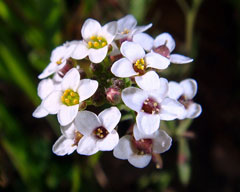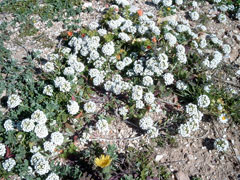 |
|
http://www.flickr.com/photos/28747427@N08/3557069668/ |
 |
| http://commons.wikimedia.org/wiki/File:Lobularia_maritima.jpg |
Translate this page:
Summary
Bloom Color: Pink, Purple, White.
Main Bloom Time: Early summer, Early fall, Late summer, Late spring, Mid summer. Form: Irregular or sprawling.
Physical Characteristics

 Lobularia maritima is a ANNUAL/PERENNIAL growing to 0.2 m (0ft 8in) by 0.3 m (1ft) at a fast rate.
Lobularia maritima is a ANNUAL/PERENNIAL growing to 0.2 m (0ft 8in) by 0.3 m (1ft) at a fast rate.
See above for USDA hardiness. It is hardy to UK zone 7. It is in leaf from April to October, in flower from June to October, and the seeds ripen from July to October. The species is hermaphrodite (has both male and female organs) and is pollinated by Insects. The plant is not self-fertile.
It is noted for attracting wildlife.
Suitable for: light (sandy), medium (loamy) and heavy (clay) soils and prefers well-drained soil. Suitable pH: mildly acid, neutral and basic (mildly alkaline) soils. It cannot grow in the shade. It prefers dry or moist soil. The plant can tolerate maritime exposure.
UK Hardiness Map
US Hardiness Map
Synonyms
Alyssum maritimum. Clypeola maritima.
Plant Habitats
Cultivated Beds; South Wall. In. West Wall. In.
Edible Uses
Edible Parts:
Edible Uses: Condiment
The young leaves, stems and flowers are sometimes used as a flavouring in salads and other dishes where pungency is required[183].
References More on Edible Uses
Medicinal Uses
Plants For A Future can not take any responsibility for any adverse effects from the use of plants. Always seek advice from a professional before using a plant medicinally.
Antiscorbutic Astringent Diuretic
The plant is commonly used in Spain as an antiscorbutic and diuretic[240]. It is also highly esteemed there as an astringent in the treatment of gonorrhoea[240].
References More on Medicinal Uses
The Bookshop: Edible Plant Books
Our Latest books on Perennial Plants For Food Forests and Permaculture Gardens in paperback or digital formats.

Edible Tropical Plants
Food Forest Plants for Hotter Conditions: 250+ Plants For Tropical Food Forests & Permaculture Gardens.
More

Edible Temperate Plants
Plants for Your Food Forest: 500 Plants for Temperate Food Forests & Permaculture Gardens.
More

More Books
PFAF have eight books available in paperback and digital formats. Browse the shop for more information.
Shop Now
Other Uses
References More on Other Uses
Cultivation details
Landscape Uses:Border, Container, Ground cover, Massing, Rock garden, Seashore. Succeeds in an ordinary garden soil in a sunny position[200]. Succeeds in sandy soils[188]. Grows well on dry walls[1]. Tolerates maritime conditions[200]. Although a short-lived perennial, it soon loses its compact habit if grown for more than one year and so is usually grown as an annual plant in gardens[245]. A very ornamental plant, there are several named forms developed for their ornamental value. This species usually self-sows in the garden if growing in a good position[1]. A fast-growing plant[188], it makes a good edging to a plant bed[245]. The forms of this species with white flowers have the refreshing scent of new-mown hay - flowers of other colours having little or no scent[245]. A good bee and butterfly plant[17, 30]. Special Features:Attractive foliage, Naturalizing, Fragrant flowers.
References Carbon Farming Information and Carbon Sequestration Information
Temperature Converter
Type a value in the Celsius field to convert the value to Fahrenheit:
Fahrenheit:
The PFAF Bookshop
Plants For A Future have a number of books available in paperback and digital form. Book titles include Edible Plants, Edible Perennials, Edible Trees,Edible Shrubs, Woodland Gardening, and Temperate Food Forest Plants. Our new book is Food Forest Plants For Hotter Conditions (Tropical and Sub-Tropical).
Shop Now
Plant Propagation
Seed - it can be sown in situ during mid to late spring and should germinate within 2 weeks[200]. Seedlings can be transplanted. In order to obtain an earlier display of the flowers, the seed can be sown in a greenhouse in late winter. When large enough to handle, the seedlings are pricked out into individual pots and are then planted out in late spring.
Other Names
If available other names are mentioned here
Native Range
TEMPERATE ASIA: Egypt (Sinai), Turkey (Islands) EUROPE: Albania, Greece (Kríti), Italy (incl. Sardinia, Sicily), Spain (incl. Baleares), France (s. & Corsica), Portugal AFRICA: Algeria (north), Egypt, Libya (north), Morocco, Tunisia
Weed Potential
Right plant wrong place. We are currently updating this section.
Please note that a plant may be invasive in one area but may not in your area so it's worth checking.
Conservation Status
IUCN Red List of Threatened Plants Status :

Growth: S = slow M = medium F = fast. Soil: L = light (sandy) M = medium H = heavy (clay). pH: A = acid N = neutral B = basic (alkaline). Shade: F = full shade S = semi-shade N = no shade. Moisture: D = dry M = Moist We = wet Wa = water.
Now available:
Food Forest Plants for Mediterranean Conditions
350+ Perennial Plants For Mediterranean and Drier Food Forests and Permaculture Gardens.
[Paperback and eBook]
This is the third in Plants For A Future's series of plant guides for food forests tailored to
specific climate zones. Following volumes on temperate and tropical ecosystems, this book focuses
on species suited to Mediterranean conditions—regions with hot, dry summers and cool, wet winters,
often facing the added challenge of climate change.
Read More
Expert comment
Author
(L.)Desv.
Botanical References
1750200
Links / References
For a list of references used on this page please go here
Readers comment
© 2010, Plants For A Future. Plants For A Future is a charitable company limited by guarantee, registered in England and Wales. Charity No. 1057719, Company No. 3204567.